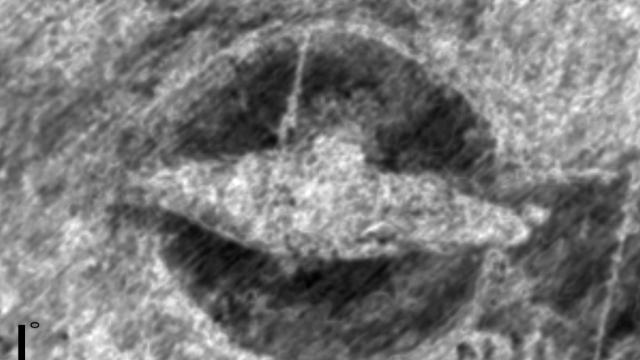Using ground-penetrating radar, archaeologists in Norway have discovered an ancient Viking ship buried just 50cm beneath the surface of a farmer’s field. The 20m-long ship, deliberately buried during a funeral ritual, appears surprisingly intact — and it could contain the skeletal remains of a high-ranking Viking warrior.
It’s called the Jellstad Ship, and it was discovered on farmland in Østfold county in southeast Norway. The site, known as Viksletta, is near the the large and fully intact Jelle burial mound, which can be seen from the busy Norwegian Rv41 118 freeway.
Archaeologists with the Norwegian Institute for Cultural Heritage Research (NIKU), with the help of radar specialists from Ludwig Boltzmann Institute for Archaeological Prospection and Virtual Archaeology (LBI ArchPro), detected the vessel using mobile ground-penetrating radar.
The discovery is significant in that it’s only the fourth Viking ship burial ever discovered, according to Knut Paasche, head of the Department of Digital Archaeology at NIKU.
“There are only a small number of ship burials known from Scandinavia so far and only three of them (Gokstad, Oseberg and Tune ships) are actually well preserved,” Erich Nau, an archaeologist with NIKU, told Gizmodo.
“The last one of these — Oseberg — was found and excavated in 1904, when archaeological methods were far less advanced than they are today. This new finding offers the possibility for modern, state-of-the-art research. Both further non-invasive methods and modern excavation and documentation methodology can now be applied and will probably lead to a much deeper understanding of the phenomenon of ship-burials.”
In addition to the ship, the scans revealed eight previously undiscovered burial mounds and several longhouses. All eight of the mounds had been plowed over by farmers, but enough evidence remained beneath the surface for the researchers to identify them as such.
In a statement, Morten Hanisch, the county conservator in Østfold, said the archaeologists “are certain that there is a ship there, but how much is preserved is hard to say before further investigation”.
The researchers haven’t dug into the topsoil yet, as they’re hoping to perform as much non-invasive work as possible using “all modern means of archaeology,” said Paasche. Indeed, the ship’s timbers, once exposed to the elements, will start to degrade immediately. What’s more, radar scans show the ship in its undisturbed condition.
The researchers are planning to perform more scans of the area, but they haven’t ruled out an excavation of the ship at some point in the future.
The ship is resting just 50cm below the topsoil, and it’s around 20m long. Preliminary scans suggest the ship’s keel and floor timbers are still intact. While the researchers have not yet dated this site, similar sites in Norway date to around 800 AD.
The researchers say the ship was deliberately buried in a burial mound, which is not as extraordinary as it might sound. Boats and ships were an indelible aspect of Viking culture, used for transportation, trade and conquest in northern Europe until about 1000 years ago. Ships were precious and considered symbols of wealth and status.
Archaeologists have found buried ships before, some even containing bodies. In 2011, for example, archaeologists in Scotland discovered a 5m-long boat with a warrior inside, along with his shield, sword, spear and other grave goods.
“Ship burials are a tradition that only exist in Scandinavia and adjoining areas during the Late Iron Age in Scandinavia — from the 6th to the 11th century — and the majority of the already excavated examples can be dated to the 9th and 10th century which is also called the Viking Age,” said Nau.
“Therefore we can assume that the new one is also from this period and thus between 1000 and 1200 years old. However, we cannot date the new findings with certainty yet — this will probably be possible only within the framework of an excavation.”
This newly discovered ship may have been part of a cemetery, which was “clearly designed to display power and influence,” archaeologist and project leader Lars Gustavsen said in a statement. There’s a very real possibility that the Jellstad Ship contains the remains of a high-ranking Viking, but that still needs to be proven.
It isn’t immediately clear if ground-penetrating radar could pick up traces of a body, or bodies; for that, ground excavations may be necessary.
Five longhouses, or halls, were also discovered by the researchers, some of which were quite large. The scientists said the site is reminiscent of another Viking site: The Borre site in Vestfold County, on the opposite side of the Oslofjord.
These findings are all very preliminary, and the researchers are preparing for the next stage of the project, which will involve more thorough scans of the Viksletta site using additional non-invasive geophysical methods. The discovery of this ancient ship is very exciting, but the best may be yet to come.
